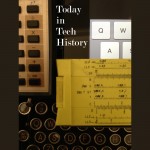 1851 – The first public message was sent on the submarine telegraph cable under the English Channel between Dover, England and Calais, France.
1851 – The first public message was sent on the submarine telegraph cable under the English Channel between Dover, England and Calais, France.
1982 – 15-year-old Scott Safran of Cherry Hill, New Jersey set the world record score on Asteroids. His record stood for 27 years, the longest-running high score in videogame history.
https://www.wired.com/2010/04/asteroids-record/
1983 – The MIT TX-0, an experimental transistorized computer, was brought back to life for the last time at The Computer Museum in Marlboro, Massachusetts.
http://www.computerhistory.org/tdih/November/13/
Read Tom’s science fiction and other fiction books at Merritt’s Books site.